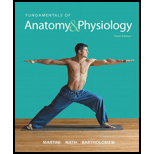
Fundamentals of Anatomy & Physiology Plus Mastering A&P with eText - Access Card Package (10th Edition) (New A&P Titles by Ric Martini and Judi Nath)
10th Edition
ISBN: 9780321908599
Author: Frederic H. Martini, Judi L. Nath, Edwin F. Bartholomew
Publisher: PEARSON
expand_more
expand_more
format_list_bulleted
Concept explainers
Question
Chapter 18, Problem 26RQ
Summary Introduction
To determine:
The name of two disorders that could produce the signs and symptoms and a test that a clinician perform for individual. When the individual has been extremely thirsty and he drinks numerous glasses of water everyday and urinates a great deal.
Concept introduction:
The lack of ADH (antidiuretic hormone) and inadequate production of insulin is the reason for the frequent thirst and frequent urination in the individual. The water reabsorption is promoted by the hormone ADH.
Expert Solution & Answer
Want to see the full answer?
Check out a sample textbook solution
Students have asked these similar questions
State the five functions of Globular Proteins, and give an example of a protein for each function.
Diagram of check cell under low power and high power
a couple in which the father has the a blood type and the mother has the o blood type produce an offspring with the o blood type, how does this happen? how could two functionally O parents produce an offspring that has the a blood type?
Chapter 18 Solutions
Fundamentals of Anatomy & Physiology Plus Mastering A&P with eText - Access Card Package (10th Edition) (New A&P Titles by Ric Martini and Judi Nath)
Ch. 18 - Prob. 1CPCh. 18 - Describe paracrine communication.Ch. 18 - Identify five mechanisms of intercellular...Ch. 18 - What primary factor determines each cells hormonal...Ch. 18 - Prob. 4CPCh. 18 - Prob. 5CPCh. 18 - Prob. 7CPCh. 18 - If a person were dehydrated, how would the amount...Ch. 18 - Prob. 9CPCh. 18 - Prob. 10CP
Ch. 18 - Prob. 11CPCh. 18 - Prob. 12CPCh. 18 - When a persons thyroid gland is removed, signs of...Ch. 18 - Prob. 14CPCh. 18 - Prob. 15CPCh. 18 - Prob. 16CPCh. 18 - Prob. 17CPCh. 18 - Prob. 18CPCh. 18 - Prob. 19CPCh. 18 - Prob. 20CPCh. 18 - Increased amounts of light would inhibit the...Ch. 18 - Prob. 22CPCh. 18 - Prob. 23CPCh. 18 - Prob. 24CPCh. 18 - Prob. 25CPCh. 18 - Prob. 26CPCh. 18 - Prob. 27CPCh. 18 - Prob. 28CPCh. 18 - Prob. 29CPCh. 18 - The lack of which hormones would inhibit skeletal...Ch. 18 - Prob. 31CPCh. 18 - Prob. 32CPCh. 18 - Prob. 33CPCh. 18 - Prob. 1RQCh. 18 - Prob. 2RQCh. 18 - Prob. 3RQCh. 18 - Prob. 4RQCh. 18 - The two hormones released by the posterior lobe of...Ch. 18 - Prob. 6RQCh. 18 - Prob. 7RQCh. 18 - Prob. 8RQCh. 18 - Prob. 9RQCh. 18 - Prob. 10RQCh. 18 - Prob. 11RQCh. 18 - Prob. 12RQCh. 18 - Prob. 13RQCh. 18 - Prob. 14RQCh. 18 - Prob. 15RQCh. 18 - Prob. 16RQCh. 18 - Prob. 17RQCh. 18 - What is the primary difference in the way the...Ch. 18 - Prob. 19RQCh. 18 - Prob. 20RQCh. 18 - Prob. 21RQCh. 18 - Prob. 22RQCh. 18 - Prob. 23RQCh. 18 - 24. Increased blood calcium levels would result in...Ch. 18 - Prob. 25RQCh. 18 - Prob. 26RQCh. 18 - Prob. 27RQCh. 18 - Prob. 28RQCh. 18 - Prob. 29RQCh. 18 - Prob. 30RQCh. 18 - Prob. 1CCCh. 18 - Prob. 2CC
Knowledge Booster
Learn more about
Need a deep-dive on the concept behind this application? Look no further. Learn more about this topic, biology and related others by exploring similar questions and additional content below.Similar questions
- What is the opening indicated by the pointer? (leaf x.s.) stomate guard cell lenticel intercellular space none of thesearrow_forwardIdentify the indicated tissue? (stem x.s.) parenchyma collenchyma sclerenchyma ○ xylem ○ phloem none of thesearrow_forwardWhere did this structure originate from? (Salix branch root) epidermis cortex endodermis pericycle vascular cylinderarrow_forward
- Identify the indicated tissue. (Tilia stem x.s.) parenchyma collenchyma sclerenchyma xylem phloem none of thesearrow_forwardIdentify the indicated structure. (Cucurbita stem l.s.) pit lenticel stomate tendril none of thesearrow_forwardIdentify the specific cell? (Zebrina leaf peel) vessel element sieve element companion cell tracheid guard cell subsidiary cell none of thesearrow_forward
- What type of cells flank the opening on either side? (leaf x.s.) vessel elements sieve elements companion cells tracheids guard cells none of thesearrow_forwardWhat specific cell is indicated. (Cucurbita stem I.s.) vessel element sieve element O companion cell tracheid guard cell none of thesearrow_forwardWhat specific cell is indicated? (Aristolochia stem x.s.) vessel element sieve element ○ companion cell O O O O O tracheid O guard cell none of thesearrow_forward
- Identify the tissue. parenchyma collenchyma sclerenchyma ○ xylem O phloem O none of thesearrow_forwardPlease answer q3arrow_forwardRespond to the following in a minimum of 175 words: How might CRISPR-Cas 9 be used in research or, eventually, therapeutically in patients? What are some potential ethical issues associated with using this technology? Do the advantages of using this technology outweigh the disadvantages (or vice versa)? Explain your position.arrow_forward
arrow_back_ios
SEE MORE QUESTIONS
arrow_forward_ios
Recommended textbooks for you
 Medical Terminology for Health Professions, Spira...Health & NutritionISBN:9781305634350Author:Ann Ehrlich, Carol L. Schroeder, Laura Ehrlich, Katrina A. SchroederPublisher:Cengage LearningUnderstanding Health Insurance: A Guide to Billin...Health & NutritionISBN:9781337679480Author:GREENPublisher:Cengage
Medical Terminology for Health Professions, Spira...Health & NutritionISBN:9781305634350Author:Ann Ehrlich, Carol L. Schroeder, Laura Ehrlich, Katrina A. SchroederPublisher:Cengage LearningUnderstanding Health Insurance: A Guide to Billin...Health & NutritionISBN:9781337679480Author:GREENPublisher:Cengage Nutrition Through The Life CycleHealth & NutritionISBN:9781337919333Author:Brown, Judith E.Publisher:Cengage Learning,
Nutrition Through The Life CycleHealth & NutritionISBN:9781337919333Author:Brown, Judith E.Publisher:Cengage Learning,

Medical Terminology for Health Professions, Spira...
Health & Nutrition
ISBN:9781305634350
Author:Ann Ehrlich, Carol L. Schroeder, Laura Ehrlich, Katrina A. Schroeder
Publisher:Cengage Learning

Understanding Health Insurance: A Guide to Billin...
Health & Nutrition
ISBN:9781337679480
Author:GREEN
Publisher:Cengage




Nutrition Through The Life Cycle
Health & Nutrition
ISBN:9781337919333
Author:Brown, Judith E.
Publisher:Cengage Learning,
How stress affects your body - Sharon Horesh Bergquist; Author: TED-Ed;https://www.youtube.com/watch?v=v-t1Z5-oPtU;License: Standard Youtube License